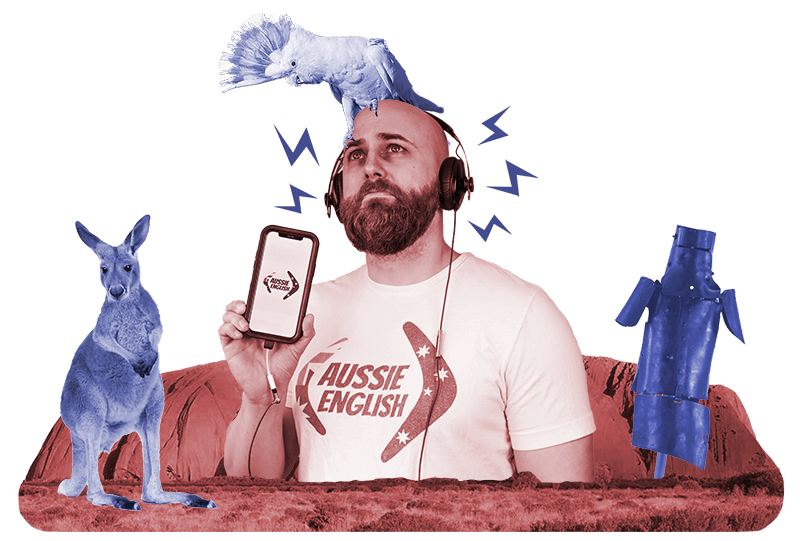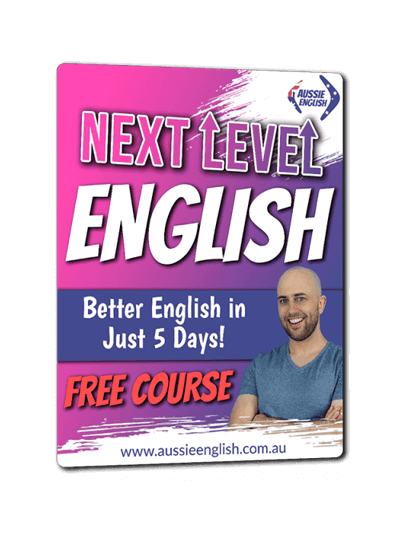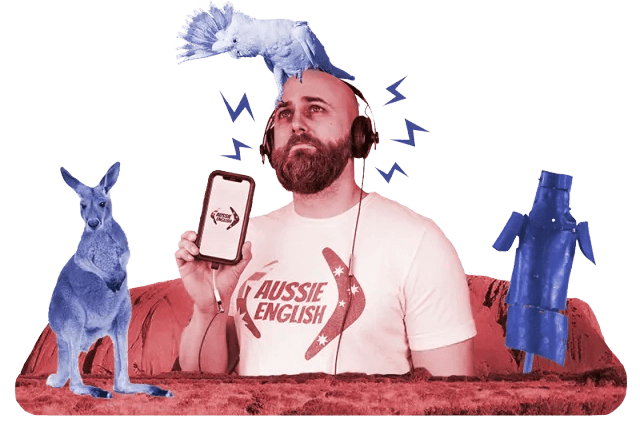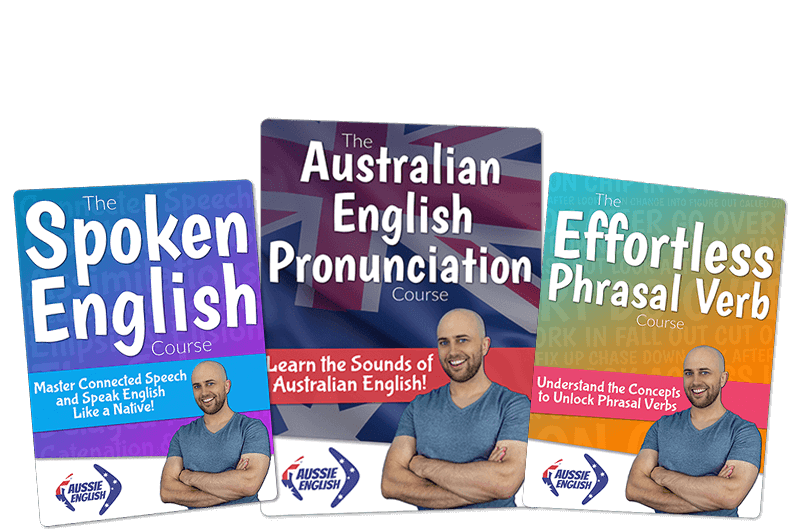
AE 1120
Verb + TO vs Verb + SO | Advanced Grammar Lesson
Learn English here on the Aussie English podcast where I teach you an advanced grammar lesson on when to use SO or TO after a VERB.

In today's episode...
Welcome to the Aussie English podcast!
In today’s video, I am going to teach you how to master using TO or SO after certain verbs.
This seems to be a massive headache for students, but learning to do SO will make you sound so much more like a native English speaker!
Can you give me examples of these sentences in your daily conversations at work?
Send it over to pete@aussieenglish.com.au
See you in the next episode!
** Want to wear the kookaburra shirt? **
Get yours here at https://aussieenglish.com.au/shirt
Improve your listening skills today – listen, play, & pause this episode – and start speaking like a native English speaker!

Watch & listen to the convo!
Listen to today's episode!
This is the FREE podcast player. You can fast-forward and rewind easily as well as slow down or speed up the audio to suit your level.
If you’d like to use the Premium Podcast Player as well as get the downloadable transcripts, audio files, and videos for episodes, you can get instant access by joining the Premium Podcast membership here.
Listen to today's episode!
Use the Premium Podcast Player below to listen and read at the same time.
You can fast-forward and rewind easily as well as slow down or speed up the audio to suit your level.
Transcript of AE 1120 - Verb + TO vs Verb + SO | Advanced Grammar Lesson
Hey, English. Yeah. Do you hope to come to the party this weekend? Yeah, I hope to. I hope to? Why not just "I hope"? Right. Okay. Do you hope that Dad will come to the party, too? Yeah, I hope so. You hope so? What, I thought it was "hope to"? Well, sometimes it's "so" and sometimes it's "to". Mum, English isn't playing by the rules again. Mate, I make the rules.
G'day, you mob. Welcome to this episode of Aussie English. I'm your host, Pete, and I've spent the last six years helping thousands of students just like you take their English to the next level. In today's episode, I'm going to help you master the use of "to and so" after certain verbs once and for all. I know this is a massive headache for students. But learning to do so is going to make you sound so much more natural when speaking English.
Before we get into it, guys, don't forget to grab today's worksheet, it is linked in the description below. You'll be able to download it, print it out, follow along as you complete this lesson, see all the phrases, all the vocab, everything like that, and you'll also get access to all of the future lessons sent straight to your email inbox. All right, are you ready? Let's go.
So, when to use "so" after verbs. So. So. So. So, when do we use "so"? We use "so" after certain verbs, when we want to replace the object clause in the sentence. Ooh, fancy, object clause. All right. All right. In layman's terms, this is the thing that the verb is acting on, so the phrase that comes after the verb. For example, "do you hope that dad comes to the party? I hope 'so'."
So, we're using "so" in order to not have to say, "yes, I hope that dad comes to the party." After the person has already said that phrase. It's inferred. It's known. Example number two, "do you expect it'll rain tomorrow? Yeah, I expect 'so'." So, again, we're using "so" instead of repeating, "it'll rain tomorrow". "So, do you expect it'll rain tomorrow? Yes, I expect that it'll rain tomorrow."
You don't have to say all of that, instead, you can just say, "yes, I expect 'so'." So, some common verbs and example sentences for each one of them. So, here are a list of common verbs that will have "so" after them, and I'll also give you an example sentence for each of them.
"Appear. Is it snowing outside? It appears so. Assume. Will he come to work? I assume so. Be afraid, as in regret. Am I pregnant? I'm afraid so. Believe. Did my team win the game? I believe so. Expect. Are you going to be late? I expect so. Guess. Are you coming? I guess so. Hope. Will you graduate soon? I hope so. Imagine. Do you reckon it'll be hot tomorrow? I imagine so.
Presume. Are they coming to the birthday party, too? I presume so. Reckon. Are the kids playing outside? I reckon so. Seem. Is that the answer? Seem so. Suppose. Will you be joining us? I suppose so. Think. Can you, do it? I think so. Note: you may sometimes hear "so" dropped after some verbs. For example, "I guess. I imagine. I reckon. I suppose."
Now, because I know how much of a clever little English learner you are, I think you notice that some of the previous phrases didn't have object clauses in them. Very clever. You are correct. However, if I were to create phrases using that verb that pairs with "so" I would use an object clause.
For example, "are you going to be late? I expect so. I expect I am going to be late. Will she graduate soon? I hope so. I hope she will graduate soon." How to negate verbs with "so". So, to negate phrases with "so" you'll either add a negated auxiliary or modal verb, usually "don't" in front of the verb, followed by "so". For example, "I don't believe so" is much more common than "I believe not". That sounds a bit formal or posh.
And the same for "I don't think so" as opposed to, "I think not". Again, bit formal, bit posh. And certain others aren't used, and they sound strange if they're said, for example, "I hope not" is much more common than "I don't hope so". I don't think anyone would say that. The same for "I guess not" instead of "I don't guess so". Again, sounds a bit weird.
Lastly, "I'm not afraid so" is never said. Instead, it'll always be "I'm afraid not". So, I've added example sentences for every single verb that we went through previously, now, where they're negated in the worksheet, so you can get that below.
Before we continue, guys, can I please ask you a teensy-weensy little favour? If you're enjoying this video and getting value out of it, please give a little boop to the like button as it will send good vibes to the YouTube algorithm and show this video to more English learners like you. It really helps small channels like mine. Thanks.
All right, part three, when to use "to". So, we use "to" after certain verbs to replace a verb clause. Ooh, fancy, a verb clause. Yeah, settle down, mate. Settle down. A verb clause is just a clause that includes a verb that the main verb in the phrase is acting on. So, in layman's terms, "to" is just replacing the rest of the phrase following the main verb.
For example, "I want to go to the shops." "To go to the shops" is the verb clause. You can just say, "I want to." "Do you need to go home?" "To go home" is the verb clause. You can just say, "do you need to?" You can do this with loads of verbs in English.
Here are some examples. "Have. Do you have to leave soon? Yeah, I have to. Want. Do you want to try it? Yeah, I want to. Need. Why are you going? Because I need to. Used. Do you like pizza? I used to. Hope. Will he get the job? He hopes to. Expect. Do you think you'll get home on time? I expect to. Get. Did you get to drive the car? Yeah, I got to. Like. Do you like to go surfing? Yeah, I like to."
So, here's a question for you guys. Can you think of any other verbs that I didn't just mention where you can use "to" to replace a verb clause after them in spoken English? Leave a comment below.
Note; "to" is a preposition that's usually unstressed in phrases, so the vowel sound /ʉː/ becomes the schwa /ə/ sound. As a result, you may hear it contracted onto verbs in spoken English, such as haveta, hasta, wanna, wansta, needa, needsta, usesta, gotta, hopeta, hopesta, etc.
Part four, negating verbs with "to". When negating verbs followed by "to" we simply insert an auxiliary verbal modal verb in front of it and negate that instead. For example, "I don't have to. She didn't want to. They haven't needed to. We didn't used to. He wouldn't get to." Again, check out today's worksheet for some example sentences.
So, that is it for today's episode, guys. Well done, making it all the way to the end. Don't forget to download my free podcast app where you can listen to all of these English lessons as audio files. You can listen whilst you're commuting to work, whilst you're at the gym, cleaning the house, going for a walk, whenever you want.
It is just a great way of working on your listening comprehension, as well as revising the English that you've learnt in these lessons. Besides that, if you want to keep learning with me, check out this video and I'll see you next time. Peace!

Listen & Read with the Premium Podcast Player
Get more out of every episode!

Premium Podcast members get access to...
- All 900+ podcast episodes including member-only episodes
- Member-only episode video lessons
- Downloadable transcript PDFs & audio files for every episode

Recent Episodes:


AE 1299 – Pete’s 2c: Do You Ring, Call, or Dial Someone on the Phone in Australia?

AE 1298 – Learn English with a Short Story: Day at the Beach

AE 1297 – The Goss: How ‘Dropping In’ Culture Has Changed in Australia

AE 1296 – The Goss: Gorilla Glasses & Dad’s Crazy Zoo Stories – MEMBERS ONLY

AE 1295 – The Goss: Australia’s Most & Least Ethical Jobs

AE 1294 – The Goss: Australia Just Had the Best Aurora in 500 Years!

AE 1293 – The Goss: Should Aussie Schools Ban Homework?

AE 1292 – How Aussie Do Asian Australians Feel? r_AskAnAustralian

Share

Join my 5-Day FREE English Course!
Complete this 5-day course and learn how to study effectively with podcasts in order to level up your English quickly whilst having fun!

Join my 5-Day FREE English Course!
Complete this 5-day course and learn how to study effectively with podcasts in order to level up your English quickly whilst having fun!


Want to improve a specific area of your English quickly and enjoyably?
Check out my series of Aussie English Courses.
English pronunciation, use of phrasal verbs, spoken English, and listening skills!

Have you got the Aussie English app?
Listen to all your favourite episodes of the Aussie English Podcast on the official AE app.
Download it for FREE below!



Want to improve a specific area of your English quickly and enjoyably?
Check out my series of Aussie English Courses.
English pronunciation, use of phrasal verbs, spoken English, and listening skills!
Leave a comment below & practice your English!






Responses
how can i have the transcript of your podcasts?
Hey mate, you can get them when you’re a Premium Podcast member. Sign up here – http://www.aussieenglish.com.au/podcast